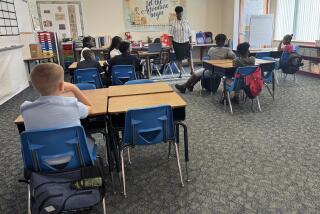One-Room Schools Get High Marks
NOVATO, Calif. â Marin County, often depicted as a land of hot tubs and luxury cars, isnât so trendy when it comes to education. Itâs cornered the market on, of all things, the one-room schoolhouse.
There are only seven one-room elementary schools in California--and three are within a few miles of each other on quiet roads in the bucolic dairy country of northern Marin.
With gables, porches and attics, not to mention the original separate entrances and cloakrooms for boys and girls, the schools seem to be relics of the past.
Inside, the picture is different. Each school has television, computers, projection equipment, a piano and an extensive library.
âI particularly love what I can do in a school like this,â said Elaine Boling, for 11 years the teacher, principal, playground director and just about everything else at Union School, which was built in 1895. âI canât even imagine teaching any other way.â
Boling has 209 students while Patty Pomi, her counterpart at nearby Lincoln School, founded in 1872, has 12. Barbara Armington at Laguna School a few miles away teaches 21 children in the one-room school founded in 1906.
âMost teachers, in the larger schools, have a child for only a year,â said Armington. âYouâre never really sure what impact youâve made on their lives. But here, I and my students are part of each othersâ lives for as much as seven years. I get to know them, see them grow, see them mature, see them learn. Itâs enormously satisfying.â
Virtually all the students come from families that own and work area dairy farms. All will go on to Petaluma Junior High School when they graduate.
âIâve yet to see any evidence that students from our one-roomers suffer any scholastic deficiency when they move on,â said Rick Sheviakov, chief psychologist for the Marin County Office of Education.
âIt may be an older approach to education, but it still works just fine,â he said.
Sheviakov said the instruction in the one-room schools is highly individualized.
âThereâs a lot more cooperation and a lot less competition. Itâs an absolute joy to watch them work together.â
Armington said she teaches her students to read in kindergarten.
âWe donât wait for the first grade like the larger schools do.â
The teachers move from student to student, guiding each of them at their own level in the subject. The students also help each other.
âItâs something you really only see in schools like this,â Boling said. âThe big help the little, the fast help the slow. They really donât compete with each other.â
Disciplinary problems are virtually nonexistent, the teachers said.
âThereâs enormous peer-group pressure not to disrupt the class,â said Boling, pointing to a list of class rules posted on the wall. âMy students drew up that list, not me. And they enforce it.â
More to Read
Sign up for Essential California
The most important California stories and recommendations in your inbox every morning.
You may occasionally receive promotional content from the Los Angeles Times.










